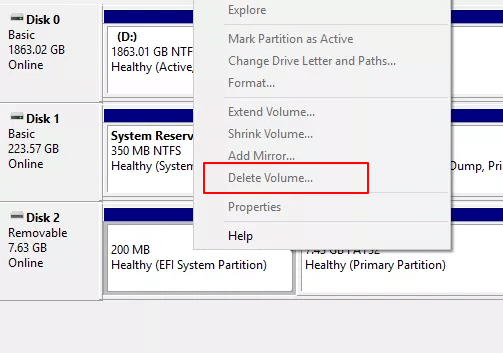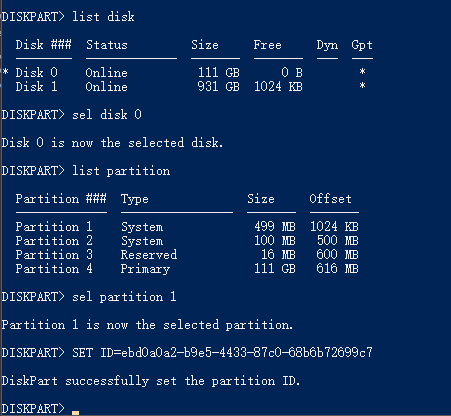How to Delete EFI (System) Partition in Windows 11/10/8/7 [2 Ways]
Can I delete the EFI system partition?
Usually, you can easily delete a partition in Disk Management. But you can't delete EFI system partition in Windows because the "Delete Volume" feature is grayed out.
The "Delete Volume" may also gray out when you try to delete the OEM partition, recovery, or system reserved partition. This page will talk about how to delete the EFI system partition on Windows, as well as the must-know information about the EFI system partition, including what EFI is and what happens when the partition is deleted.
To efficiently remove EFI partition from your computer, you can fully trust Qiling partition manager software as shown in Part 3. Keep reading and learn more details.

- Part 1. What is the EFI System Partition (ESP)
- Part 2. What Will Happen if You Delete an EFI Partition
- Part 3. 2 Methods to Delete EFI System Partition
Part 1. What Is EFI System Partition (ESP)
EFI partition, also known as EFI system partition, short for ESP, is automatically generated when you successfully install Windows OS on a GPT disk in your computer. It takes about 100M or 200MB or so with no drive letter. Normally, you may see more EFI system partition on Windows 10.
According to Wikipedia, "EFI system partition (ESP) is a partition on a data storage device which is used computers adhering to UEFI (Unified Extensible Firmware Interface). When a computer is booted, UEFI firmware loads files stored on the ESP(EFI system partition) to start installed operating system and various utilities."
It includes 4 main components:
- Boot loaders
- Device drivers
- System utilities
- Data files

Part 2. What Happens If You Delete EFI System Partition (ESP)
According to Part 1, the EFI partition is like an interface for the computer to boot Windows off. It's a pre-step that must be taken before running the Windows partition. Without the EFI partition, your computer won't be able to boot into Windows.
In a word, EFI system partition deletion will cause the installed system unbootable. Therefore, EFI system partition is usually protected and locked by the Windows operating systems to prevent and avoid accidental deletion. That's why you can't see the EFI partition in Windows File Explorer nor delete it using Windows Disk Management.
- Important
- 1. If you want to keep your Windows OS running smoothly, don't do anything to the EFI system partition.
- 2. If your hard drive is getting full, follow to learn what is taking up space on the hard drive and use the right ways to free up disk space.
- 3. If you installed two Windows systems on your PC and want to delete the ESP, freeing up disk space and just keeping one OS, follow methods in Part 3 for help.
- 4. If you want to delete the EFI partition and install a new Windows OS, you can directly reinstall the OS. The ESP will be automatically removed.
Part 3. How to Delete EFI (System) Partition in Windows 11/10/8/7 [2 Methods]
For users who want to delete the EFI system, there are two methods available. One is to delete with the Windows built-in tool - Diskpart and the other is to apply a simple third-party tool - Qiling Partition Master. To avoid unnecessary file loss, make sure you have backed up the ESP files in advance.
Method 1. Delete EFI Partition Using Qiling Partition Manager
Besides DiskPart, third-party partition manager software works more flexibly and reliable in dealing with this issue. Professional partition manager software - Qiling Partition Master simplifies the process of deleting EFI partitions in Windows as easy as 1-2-3.
Now download Qiling Partition Master and learn the detailed guide.
- Qiling Partition Master -
Your Smart Windows 11 Update Disk Manager
- MBR to GPT Converter, Make Disk Ready for Windows 11.
- Migrate Windows 11 to New SSD in 1-Click.
- Handy to Extend or Combine Partitions in Windows 11.
- Clone and Upgrade Disks without Data Loss.
Step 1. To delete a system involved partition like the EFI system partition, you'll be asked to operate in a WinPE environment. So first of all, use the feature of "WinPE Creator" in Qiling Partition Master to create a bootable USB drive to start. Click to get the full guide on how to create and access Qiling WinPE bootable disk.
Step 2. Open Qiling Partition Master WinPE edition. Click on the EFI system partition and choose "Delete".

Step 3. Click "OK" to confirm the message "Are you sure you want to delete the selected partition?".
Method 2. Delete EFI System Partition with Diskpart
As a command-line utility, DiskPart is sort of complex for average users to apply. Please be very careful while following the below command lines to delete EFI partition:
Step 1. Open DiskPart on your PC.
- 1. Hit "Windows Key + R" to open the run dialogue box.
- 2. Enter diskpart and click "OK" to open a black command prompt window.
Step 2. Change EFI system partition ID and set it as a data partition.
Type the below command lines and hit Enter each time:
- "list disk" (It displays all the disks of your computer. )
- "sel disk 0" (It identifies which disk you need to work with. Here 0 stands for the disk letter.)
- "list partition" (It displays all partitions and EFI system partitions on the selected disk.)
- "sel partition 1" (Select the EFI partition that you want to delete. Here, 1 stands for the volume number of EFI.)
- "SET ID=ebd0a0a2-b9e5-4433-87c0-68b6b72699c7"

By doing so, it will make the EFI system partition deletable. Continue with the following steps to remove this partition on your hard drive.
Step 3. Delete the EFI partition with the command line.
Type the below command lines and hit Enter each time:
- "list partition" (It displays all the volumes on the hard drive.)
- "sel partition 1" (It identifies which partition you want to remove. Here 1 stands for the volume letter.)
- "delete partition override" (It removes the EFI partition from Windows disk.)
Step 4. Complete EFI deleting process.
Finally, type "exit" to close the windows when you receive the message that says, 'DiskPart successfully deleted the selected partition'.
Final Word
When you've successfully deleted the EFI partition on your PC, you can create a new partition with the unallocated space to use as a data partition or add the free space to other existing partitions.
The following tutorial shows how to partition a hard drive with Qiling Partition Master. You can learn how to resize a partition, create a partition, and delete the partition.
If you are having some more questions about EFI partitions, you may refer to the below links for help:
Related Articles
- [Fixed] There Is No exFAT Format Option in Windows 11/10/8.1/8/7
- 3 Best Disk Repair Tools for Windows Server Free Download 2022
- How to Expand RAID 5 Array Partitions in 2022 [New]
- 7 Top Best Free Disk Partition Software For Windows in 2022